Business Law Report: UK Legal System, Business Impact, Organizations
VerifiedAdded on 2021/02/20
|12
|3814
|89
Report
AI Summary
This report provides a comprehensive analysis of UK business law, beginning with an introduction to the English legal system, its sources, and the role of the government in law-making. It then delves into the impact of company, employment, and contract law on businesses, offering relevant examples. The report further explores different types of legally formed business organizations, including incorporated and unincorporated businesses, and discusses their management and funding. Finally, it offers recommendations for resolving a range of business disputes, providing a well-rounded understanding of the subject matter. The report is structured with clear learning objectives and includes references for further study.

BUSINESS Law
Paraphrase This Document
Need a fresh take? Get an instant paraphrase of this document with our AI Paraphraser
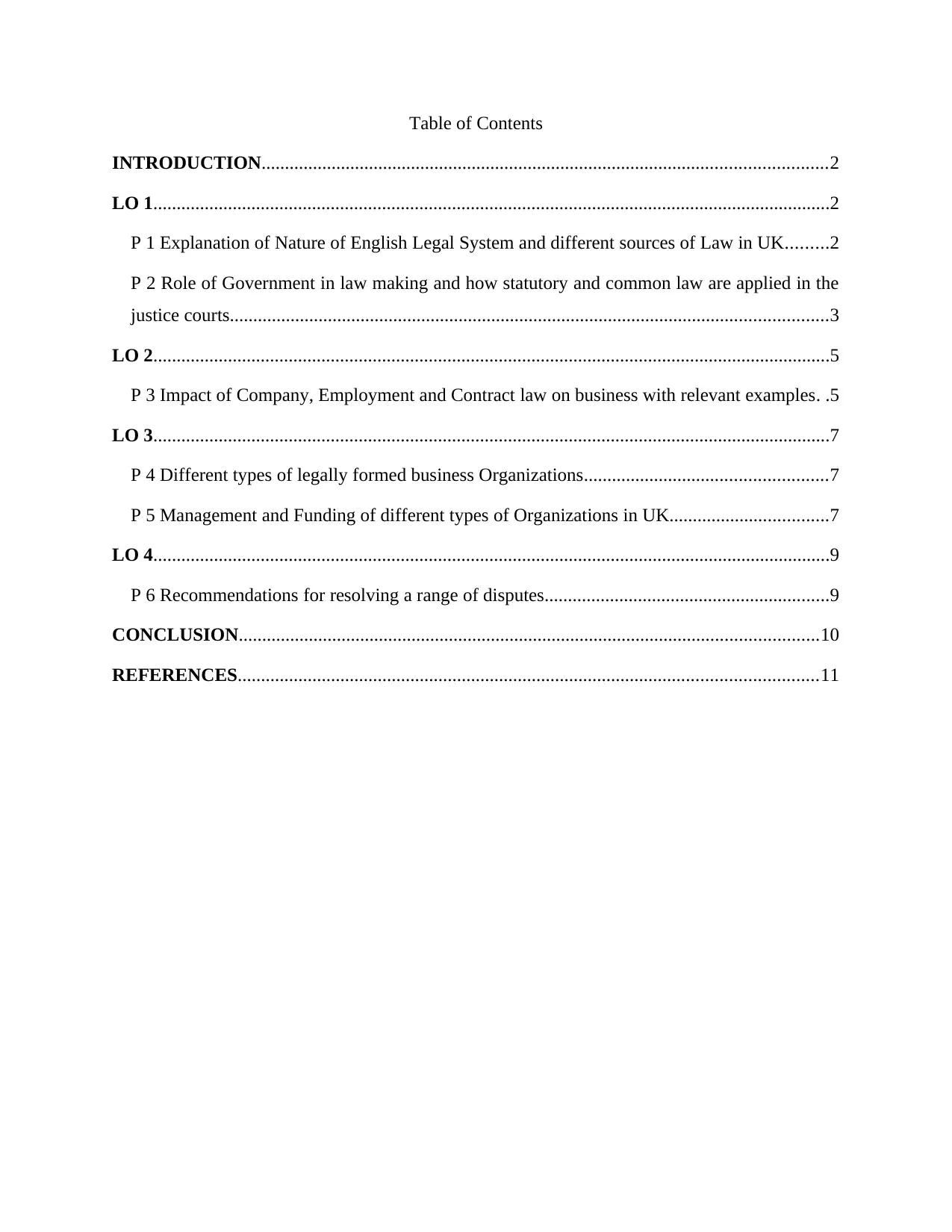
Table of Contents
INTRODUCTION.........................................................................................................................2
LO 1.................................................................................................................................................2
P 1 Explanation of Nature of English Legal System and different sources of Law in UK.........2
P 2 Role of Government in law making and how statutory and common law are applied in the
justice courts................................................................................................................................3
LO 2.................................................................................................................................................5
P 3 Impact of Company, Employment and Contract law on business with relevant examples. .5
LO 3.................................................................................................................................................7
P 4 Different types of legally formed business Organizations....................................................7
P 5 Management and Funding of different types of Organizations in UK..................................7
LO 4.................................................................................................................................................9
P 6 Recommendations for resolving a range of disputes.............................................................9
CONCLUSION............................................................................................................................10
REFERENCES............................................................................................................................11
INTRODUCTION.........................................................................................................................2
LO 1.................................................................................................................................................2
P 1 Explanation of Nature of English Legal System and different sources of Law in UK.........2
P 2 Role of Government in law making and how statutory and common law are applied in the
justice courts................................................................................................................................3
LO 2.................................................................................................................................................5
P 3 Impact of Company, Employment and Contract law on business with relevant examples. .5
LO 3.................................................................................................................................................7
P 4 Different types of legally formed business Organizations....................................................7
P 5 Management and Funding of different types of Organizations in UK..................................7
LO 4.................................................................................................................................................9
P 6 Recommendations for resolving a range of disputes.............................................................9
CONCLUSION............................................................................................................................10
REFERENCES............................................................................................................................11
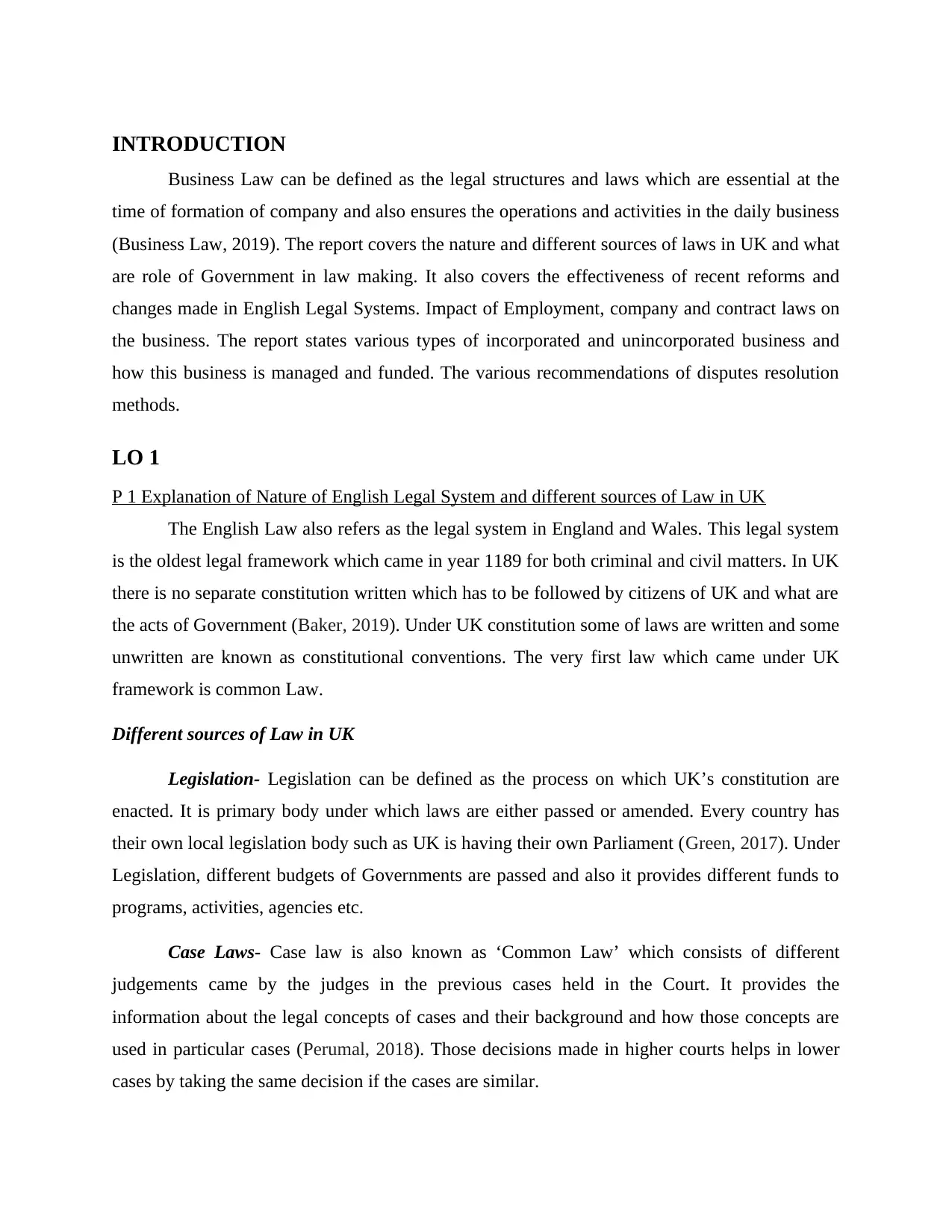
INTRODUCTION
Business Law can be defined as the legal structures and laws which are essential at the
time of formation of company and also ensures the operations and activities in the daily business
(Business Law, 2019). The report covers the nature and different sources of laws in UK and what
are role of Government in law making. It also covers the effectiveness of recent reforms and
changes made in English Legal Systems. Impact of Employment, company and contract laws on
the business. The report states various types of incorporated and unincorporated business and
how this business is managed and funded. The various recommendations of disputes resolution
methods.
LO 1
P 1 Explanation of Nature of English Legal System and different sources of Law in UK
The English Law also refers as the legal system in England and Wales. This legal system
is the oldest legal framework which came in year 1189 for both criminal and civil matters. In UK
there is no separate constitution written which has to be followed by citizens of UK and what are
the acts of Government (Baker, 2019). Under UK constitution some of laws are written and some
unwritten are known as constitutional conventions. The very first law which came under UK
framework is common Law.
Different sources of Law in UK
Legislation- Legislation can be defined as the process on which UK’s constitution are
enacted. It is primary body under which laws are either passed or amended. Every country has
their own local legislation body such as UK is having their own Parliament (Green, 2017). Under
Legislation, different budgets of Governments are passed and also it provides different funds to
programs, activities, agencies etc.
Case Laws- Case law is also known as ‘Common Law’ which consists of different
judgements came by the judges in the previous cases held in the Court. It provides the
information about the legal concepts of cases and their background and how those concepts are
used in particular cases (Perumal, 2018). Those decisions made in higher courts helps in lower
cases by taking the same decision if the cases are similar.
Business Law can be defined as the legal structures and laws which are essential at the
time of formation of company and also ensures the operations and activities in the daily business
(Business Law, 2019). The report covers the nature and different sources of laws in UK and what
are role of Government in law making. It also covers the effectiveness of recent reforms and
changes made in English Legal Systems. Impact of Employment, company and contract laws on
the business. The report states various types of incorporated and unincorporated business and
how this business is managed and funded. The various recommendations of disputes resolution
methods.
LO 1
P 1 Explanation of Nature of English Legal System and different sources of Law in UK
The English Law also refers as the legal system in England and Wales. This legal system
is the oldest legal framework which came in year 1189 for both criminal and civil matters. In UK
there is no separate constitution written which has to be followed by citizens of UK and what are
the acts of Government (Baker, 2019). Under UK constitution some of laws are written and some
unwritten are known as constitutional conventions. The very first law which came under UK
framework is common Law.
Different sources of Law in UK
Legislation- Legislation can be defined as the process on which UK’s constitution are
enacted. It is primary body under which laws are either passed or amended. Every country has
their own local legislation body such as UK is having their own Parliament (Green, 2017). Under
Legislation, different budgets of Governments are passed and also it provides different funds to
programs, activities, agencies etc.
Case Laws- Case law is also known as ‘Common Law’ which consists of different
judgements came by the judges in the previous cases held in the Court. It provides the
information about the legal concepts of cases and their background and how those concepts are
used in particular cases (Perumal, 2018). Those decisions made in higher courts helps in lower
cases by taking the same decision if the cases are similar.
⊘ This is a preview!⊘
Do you want full access?
Subscribe today to unlock all pages.

Trusted by 1+ million students worldwide
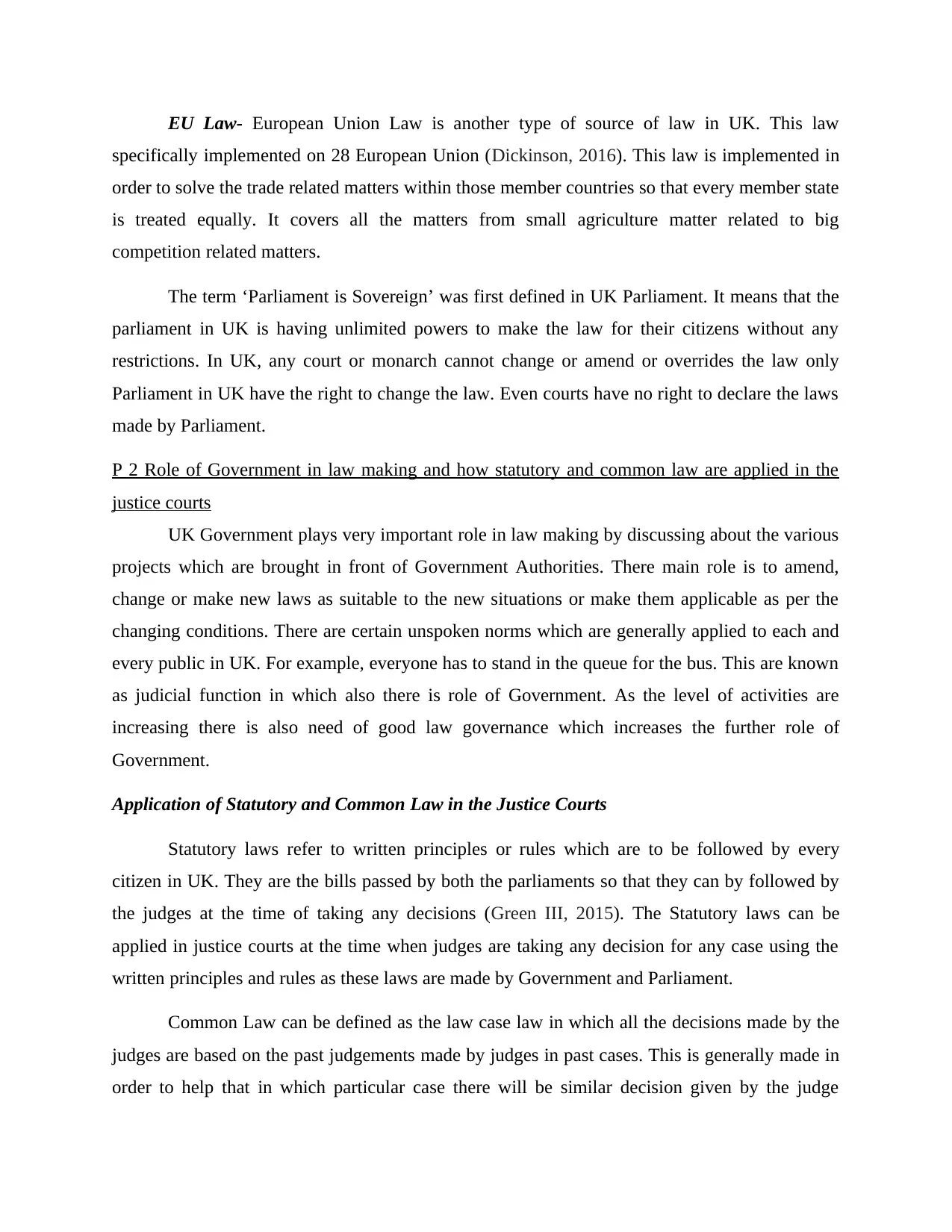
EU Law- European Union Law is another type of source of law in UK. This law
specifically implemented on 28 European Union (Dickinson, 2016). This law is implemented in
order to solve the trade related matters within those member countries so that every member state
is treated equally. It covers all the matters from small agriculture matter related to big
competition related matters.
The term ‘Parliament is Sovereign’ was first defined in UK Parliament. It means that the
parliament in UK is having unlimited powers to make the law for their citizens without any
restrictions. In UK, any court or monarch cannot change or amend or overrides the law only
Parliament in UK have the right to change the law. Even courts have no right to declare the laws
made by Parliament.
P 2 Role of Government in law making and how statutory and common law are applied in the
justice courts
UK Government plays very important role in law making by discussing about the various
projects which are brought in front of Government Authorities. There main role is to amend,
change or make new laws as suitable to the new situations or make them applicable as per the
changing conditions. There are certain unspoken norms which are generally applied to each and
every public in UK. For example, everyone has to stand in the queue for the bus. This are known
as judicial function in which also there is role of Government. As the level of activities are
increasing there is also need of good law governance which increases the further role of
Government.
Application of Statutory and Common Law in the Justice Courts
Statutory laws refer to written principles or rules which are to be followed by every
citizen in UK. They are the bills passed by both the parliaments so that they can by followed by
the judges at the time of taking any decisions (Green III, 2015). The Statutory laws can be
applied in justice courts at the time when judges are taking any decision for any case using the
written principles and rules as these laws are made by Government and Parliament.
Common Law can be defined as the law case law in which all the decisions made by the
judges are based on the past judgements made by judges in past cases. This is generally made in
order to help that in which particular case there will be similar decision given by the judge
specifically implemented on 28 European Union (Dickinson, 2016). This law is implemented in
order to solve the trade related matters within those member countries so that every member state
is treated equally. It covers all the matters from small agriculture matter related to big
competition related matters.
The term ‘Parliament is Sovereign’ was first defined in UK Parliament. It means that the
parliament in UK is having unlimited powers to make the law for their citizens without any
restrictions. In UK, any court or monarch cannot change or amend or overrides the law only
Parliament in UK have the right to change the law. Even courts have no right to declare the laws
made by Parliament.
P 2 Role of Government in law making and how statutory and common law are applied in the
justice courts
UK Government plays very important role in law making by discussing about the various
projects which are brought in front of Government Authorities. There main role is to amend,
change or make new laws as suitable to the new situations or make them applicable as per the
changing conditions. There are certain unspoken norms which are generally applied to each and
every public in UK. For example, everyone has to stand in the queue for the bus. This are known
as judicial function in which also there is role of Government. As the level of activities are
increasing there is also need of good law governance which increases the further role of
Government.
Application of Statutory and Common Law in the Justice Courts
Statutory laws refer to written principles or rules which are to be followed by every
citizen in UK. They are the bills passed by both the parliaments so that they can by followed by
the judges at the time of taking any decisions (Green III, 2015). The Statutory laws can be
applied in justice courts at the time when judges are taking any decision for any case using the
written principles and rules as these laws are made by Government and Parliament.
Common Law can be defined as the law case law in which all the decisions made by the
judges are based on the past judgements made by judges in past cases. This is generally made in
order to help that in which particular case there will be similar decision given by the judge
Paraphrase This Document
Need a fresh take? Get an instant paraphrase of this document with our AI Paraphraser
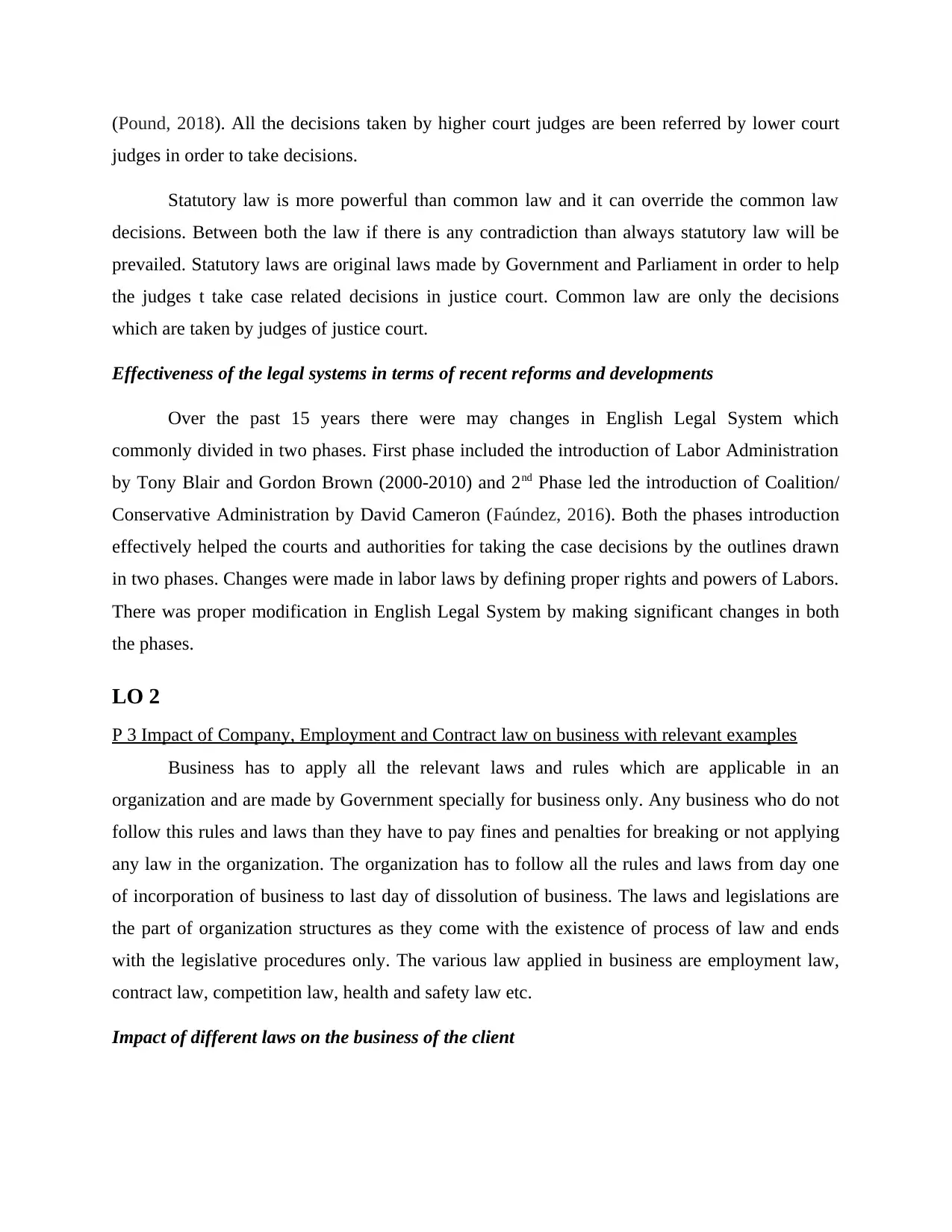
(Pound, 2018). All the decisions taken by higher court judges are been referred by lower court
judges in order to take decisions.
Statutory law is more powerful than common law and it can override the common law
decisions. Between both the law if there is any contradiction than always statutory law will be
prevailed. Statutory laws are original laws made by Government and Parliament in order to help
the judges t take case related decisions in justice court. Common law are only the decisions
which are taken by judges of justice court.
Effectiveness of the legal systems in terms of recent reforms and developments
Over the past 15 years there were may changes in English Legal System which
commonly divided in two phases. First phase included the introduction of Labor Administration
by Tony Blair and Gordon Brown (2000-2010) and 2nd Phase led the introduction of Coalition/
Conservative Administration by David Cameron (Faúndez, 2016). Both the phases introduction
effectively helped the courts and authorities for taking the case decisions by the outlines drawn
in two phases. Changes were made in labor laws by defining proper rights and powers of Labors.
There was proper modification in English Legal System by making significant changes in both
the phases.
LO 2
P 3 Impact of Company, Employment and Contract law on business with relevant examples
Business has to apply all the relevant laws and rules which are applicable in an
organization and are made by Government specially for business only. Any business who do not
follow this rules and laws than they have to pay fines and penalties for breaking or not applying
any law in the organization. The organization has to follow all the rules and laws from day one
of incorporation of business to last day of dissolution of business. The laws and legislations are
the part of organization structures as they come with the existence of process of law and ends
with the legislative procedures only. The various law applied in business are employment law,
contract law, competition law, health and safety law etc.
Impact of different laws on the business of the client
judges in order to take decisions.
Statutory law is more powerful than common law and it can override the common law
decisions. Between both the law if there is any contradiction than always statutory law will be
prevailed. Statutory laws are original laws made by Government and Parliament in order to help
the judges t take case related decisions in justice court. Common law are only the decisions
which are taken by judges of justice court.
Effectiveness of the legal systems in terms of recent reforms and developments
Over the past 15 years there were may changes in English Legal System which
commonly divided in two phases. First phase included the introduction of Labor Administration
by Tony Blair and Gordon Brown (2000-2010) and 2nd Phase led the introduction of Coalition/
Conservative Administration by David Cameron (Faúndez, 2016). Both the phases introduction
effectively helped the courts and authorities for taking the case decisions by the outlines drawn
in two phases. Changes were made in labor laws by defining proper rights and powers of Labors.
There was proper modification in English Legal System by making significant changes in both
the phases.
LO 2
P 3 Impact of Company, Employment and Contract law on business with relevant examples
Business has to apply all the relevant laws and rules which are applicable in an
organization and are made by Government specially for business only. Any business who do not
follow this rules and laws than they have to pay fines and penalties for breaking or not applying
any law in the organization. The organization has to follow all the rules and laws from day one
of incorporation of business to last day of dissolution of business. The laws and legislations are
the part of organization structures as they come with the existence of process of law and ends
with the legislative procedures only. The various law applied in business are employment law,
contract law, competition law, health and safety law etc.
Impact of different laws on the business of the client
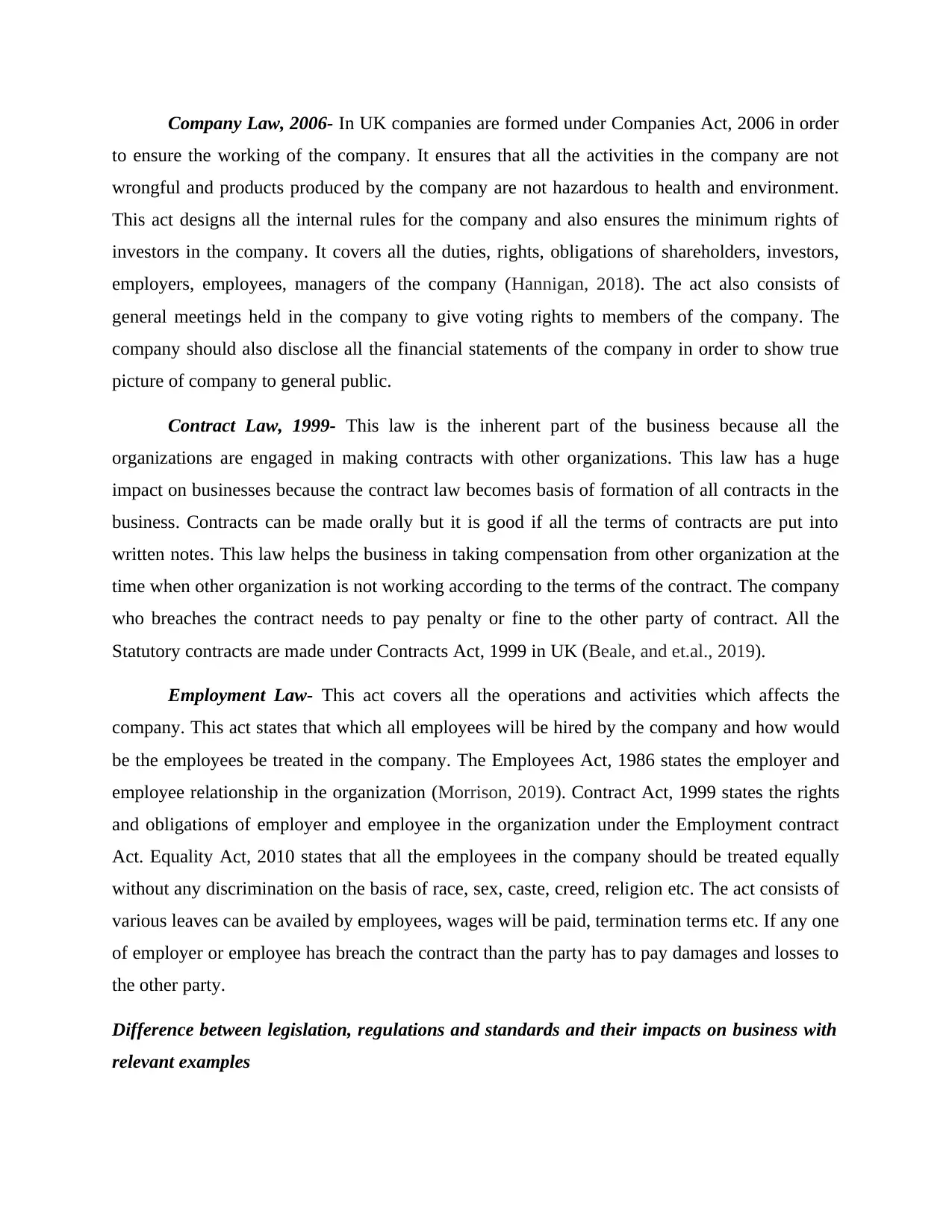
Company Law, 2006- In UK companies are formed under Companies Act, 2006 in order
to ensure the working of the company. It ensures that all the activities in the company are not
wrongful and products produced by the company are not hazardous to health and environment.
This act designs all the internal rules for the company and also ensures the minimum rights of
investors in the company. It covers all the duties, rights, obligations of shareholders, investors,
employers, employees, managers of the company (Hannigan, 2018). The act also consists of
general meetings held in the company to give voting rights to members of the company. The
company should also disclose all the financial statements of the company in order to show true
picture of company to general public.
Contract Law, 1999- This law is the inherent part of the business because all the
organizations are engaged in making contracts with other organizations. This law has a huge
impact on businesses because the contract law becomes basis of formation of all contracts in the
business. Contracts can be made orally but it is good if all the terms of contracts are put into
written notes. This law helps the business in taking compensation from other organization at the
time when other organization is not working according to the terms of the contract. The company
who breaches the contract needs to pay penalty or fine to the other party of contract. All the
Statutory contracts are made under Contracts Act, 1999 in UK (Beale, and et.al., 2019).
Employment Law- This act covers all the operations and activities which affects the
company. This act states that which all employees will be hired by the company and how would
be the employees be treated in the company. The Employees Act, 1986 states the employer and
employee relationship in the organization (Morrison, 2019). Contract Act, 1999 states the rights
and obligations of employer and employee in the organization under the Employment contract
Act. Equality Act, 2010 states that all the employees in the company should be treated equally
without any discrimination on the basis of race, sex, caste, creed, religion etc. The act consists of
various leaves can be availed by employees, wages will be paid, termination terms etc. If any one
of employer or employee has breach the contract than the party has to pay damages and losses to
the other party.
Difference between legislation, regulations and standards and their impacts on business with
relevant examples
to ensure the working of the company. It ensures that all the activities in the company are not
wrongful and products produced by the company are not hazardous to health and environment.
This act designs all the internal rules for the company and also ensures the minimum rights of
investors in the company. It covers all the duties, rights, obligations of shareholders, investors,
employers, employees, managers of the company (Hannigan, 2018). The act also consists of
general meetings held in the company to give voting rights to members of the company. The
company should also disclose all the financial statements of the company in order to show true
picture of company to general public.
Contract Law, 1999- This law is the inherent part of the business because all the
organizations are engaged in making contracts with other organizations. This law has a huge
impact on businesses because the contract law becomes basis of formation of all contracts in the
business. Contracts can be made orally but it is good if all the terms of contracts are put into
written notes. This law helps the business in taking compensation from other organization at the
time when other organization is not working according to the terms of the contract. The company
who breaches the contract needs to pay penalty or fine to the other party of contract. All the
Statutory contracts are made under Contracts Act, 1999 in UK (Beale, and et.al., 2019).
Employment Law- This act covers all the operations and activities which affects the
company. This act states that which all employees will be hired by the company and how would
be the employees be treated in the company. The Employees Act, 1986 states the employer and
employee relationship in the organization (Morrison, 2019). Contract Act, 1999 states the rights
and obligations of employer and employee in the organization under the Employment contract
Act. Equality Act, 2010 states that all the employees in the company should be treated equally
without any discrimination on the basis of race, sex, caste, creed, religion etc. The act consists of
various leaves can be availed by employees, wages will be paid, termination terms etc. If any one
of employer or employee has breach the contract than the party has to pay damages and losses to
the other party.
Difference between legislation, regulations and standards and their impacts on business with
relevant examples
⊘ This is a preview!⊘
Do you want full access?
Subscribe today to unlock all pages.

Trusted by 1+ million students worldwide

Legislation can be defined as the principles and rules passed by Parliament or
Government. Legislations are mandatory to be followed by every citizen in UK without making
in modification and changes in those principles. Regulations are the outlines and guidelines
which helps in interpreting and understating the laws that what they actually mean. Standards are
slightly different from legislations and regulations (Ito, 2018). Standards are the set laws and
rules by Government bodies in to ensure the set bars for the operations and activities of the
company. Legislations are mandatory to be followed whereas regulations are used in order to
know the correct meaning of laws and standards are the set bars which may or may not be
followed by the company. Standards are the generally accepted rules and practices which makes
them easy for the companies to follow the best practice.
For example, Employment Rights Act, 1996 states the employer and employee relationship that
has to be followed in the company under Employment contract. Under Employment Regulations
Act, 1999 are the outlines for understanding the rights and duties if employer and employee
relationship in the company. Health and Safety Act, 2000 is the part of Employment Act states
the safe and healthy environment for the employees in which the employees have to work in.
Thus, it signifies that laws are mandatory to be followed, regulations are only outlining and
standards are set bars to be followed by company in UK.
LO 3
P 4 Different types of legally formed business Organizations
Incorporated Business- Incorporated Business are those businesses which are registered
under Companies Act, 2006. There is various business such as Limited Company, LLP. Under
this business, company is having their own assets and liabilities. The company have a separate
legal identity in the eyes of law and company can be sued or can sue any person. The liability of
shareholders, investors and owners are limited up to their investment in the company (Henning,
2015). Even the directors of the company are not liable for all the payment of liabilities of the
company and cannot be held responsible for the defaults until the corporate veil is lifted.
Unincorporated Business- This business can be registered under any legal system of UK.
It includes the various business such as partnership and sole trader. These businesses are run and
formed by the owners themselves. Profits generated under this business are distributed among
partners and owners themselves (Steinberg, 2016). All the capital in the business are brought in
Government. Legislations are mandatory to be followed by every citizen in UK without making
in modification and changes in those principles. Regulations are the outlines and guidelines
which helps in interpreting and understating the laws that what they actually mean. Standards are
slightly different from legislations and regulations (Ito, 2018). Standards are the set laws and
rules by Government bodies in to ensure the set bars for the operations and activities of the
company. Legislations are mandatory to be followed whereas regulations are used in order to
know the correct meaning of laws and standards are the set bars which may or may not be
followed by the company. Standards are the generally accepted rules and practices which makes
them easy for the companies to follow the best practice.
For example, Employment Rights Act, 1996 states the employer and employee relationship that
has to be followed in the company under Employment contract. Under Employment Regulations
Act, 1999 are the outlines for understanding the rights and duties if employer and employee
relationship in the company. Health and Safety Act, 2000 is the part of Employment Act states
the safe and healthy environment for the employees in which the employees have to work in.
Thus, it signifies that laws are mandatory to be followed, regulations are only outlining and
standards are set bars to be followed by company in UK.
LO 3
P 4 Different types of legally formed business Organizations
Incorporated Business- Incorporated Business are those businesses which are registered
under Companies Act, 2006. There is various business such as Limited Company, LLP. Under
this business, company is having their own assets and liabilities. The company have a separate
legal identity in the eyes of law and company can be sued or can sue any person. The liability of
shareholders, investors and owners are limited up to their investment in the company (Henning,
2015). Even the directors of the company are not liable for all the payment of liabilities of the
company and cannot be held responsible for the defaults until the corporate veil is lifted.
Unincorporated Business- This business can be registered under any legal system of UK.
It includes the various business such as partnership and sole trader. These businesses are run and
formed by the owners themselves. Profits generated under this business are distributed among
partners and owners themselves (Steinberg, 2016). All the capital in the business are brought in
Paraphrase This Document
Need a fresh take? Get an instant paraphrase of this document with our AI Paraphraser
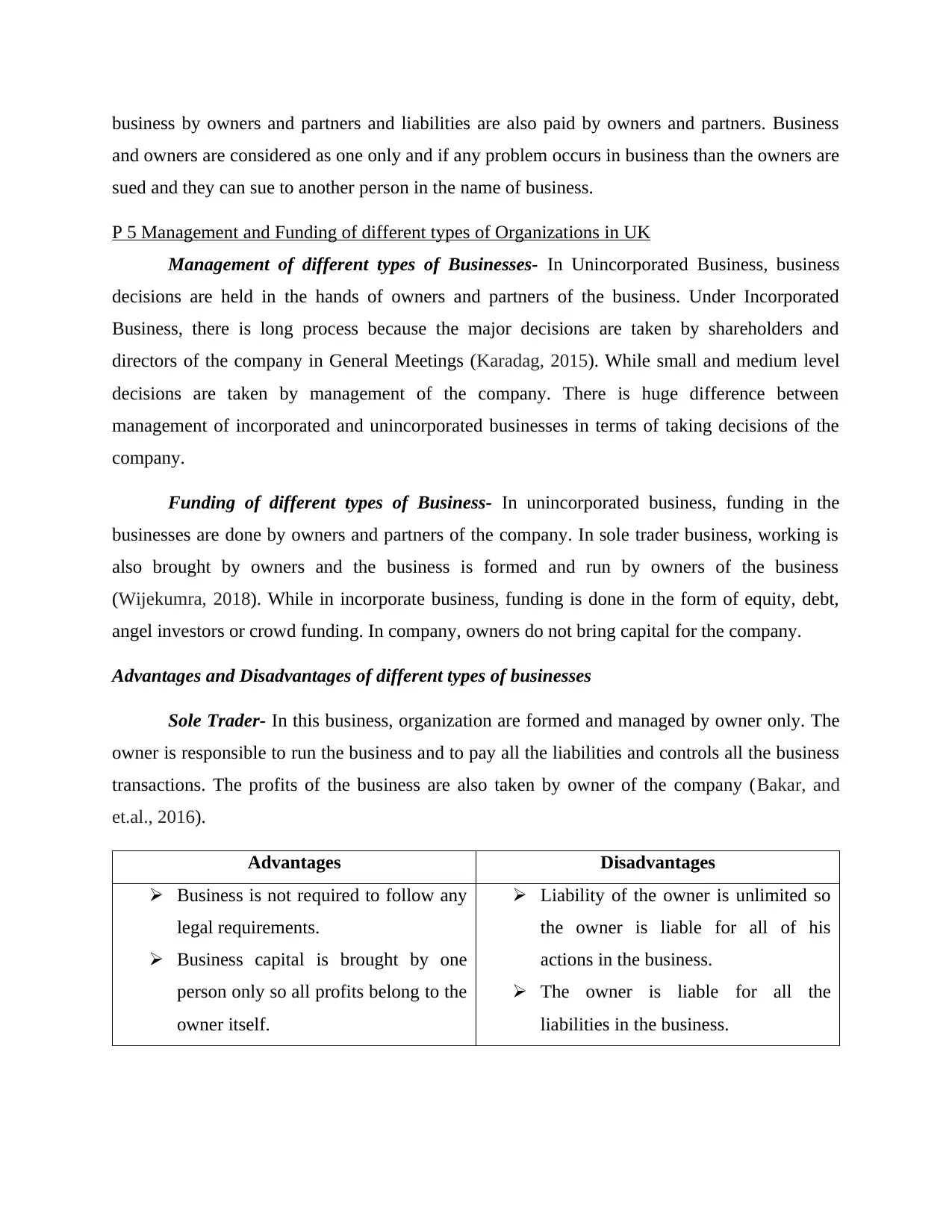
business by owners and partners and liabilities are also paid by owners and partners. Business
and owners are considered as one only and if any problem occurs in business than the owners are
sued and they can sue to another person in the name of business.
P 5 Management and Funding of different types of Organizations in UK
Management of different types of Businesses- In Unincorporated Business, business
decisions are held in the hands of owners and partners of the business. Under Incorporated
Business, there is long process because the major decisions are taken by shareholders and
directors of the company in General Meetings (Karadag, 2015). While small and medium level
decisions are taken by management of the company. There is huge difference between
management of incorporated and unincorporated businesses in terms of taking decisions of the
company.
Funding of different types of Business- In unincorporated business, funding in the
businesses are done by owners and partners of the company. In sole trader business, working is
also brought by owners and the business is formed and run by owners of the business
(Wijekumra, 2018). While in incorporate business, funding is done in the form of equity, debt,
angel investors or crowd funding. In company, owners do not bring capital for the company.
Advantages and Disadvantages of different types of businesses
Sole Trader- In this business, organization are formed and managed by owner only. The
owner is responsible to run the business and to pay all the liabilities and controls all the business
transactions. The profits of the business are also taken by owner of the company (Bakar, and
et.al., 2016).
Advantages Disadvantages
Business is not required to follow any
legal requirements.
Business capital is brought by one
person only so all profits belong to the
owner itself.
Liability of the owner is unlimited so
the owner is liable for all of his
actions in the business.
The owner is liable for all the
liabilities in the business.
and owners are considered as one only and if any problem occurs in business than the owners are
sued and they can sue to another person in the name of business.
P 5 Management and Funding of different types of Organizations in UK
Management of different types of Businesses- In Unincorporated Business, business
decisions are held in the hands of owners and partners of the business. Under Incorporated
Business, there is long process because the major decisions are taken by shareholders and
directors of the company in General Meetings (Karadag, 2015). While small and medium level
decisions are taken by management of the company. There is huge difference between
management of incorporated and unincorporated businesses in terms of taking decisions of the
company.
Funding of different types of Business- In unincorporated business, funding in the
businesses are done by owners and partners of the company. In sole trader business, working is
also brought by owners and the business is formed and run by owners of the business
(Wijekumra, 2018). While in incorporate business, funding is done in the form of equity, debt,
angel investors or crowd funding. In company, owners do not bring capital for the company.
Advantages and Disadvantages of different types of businesses
Sole Trader- In this business, organization are formed and managed by owner only. The
owner is responsible to run the business and to pay all the liabilities and controls all the business
transactions. The profits of the business are also taken by owner of the company (Bakar, and
et.al., 2016).
Advantages Disadvantages
Business is not required to follow any
legal requirements.
Business capital is brought by one
person only so all profits belong to the
owner itself.
Liability of the owner is unlimited so
the owner is liable for all of his
actions in the business.
The owner is liable for all the
liabilities in the business.

Partnership- Minimum number of Partners need to form partnership are two. All the
capital is in the business is funded by partners and profits are distributed among partners itself.
Advantages Disadvantages
The partners are responsible for the
business transactions.
The capital is shared among the
partners in the business.
More minds in the business can led to
the disputes among partners itself.
One partner may have more
responsibilities of business as
compared to the other partner
(McCarthy, 2016).
Limited Company- The companies are registered under Companies Act, 2006. Under this act,
business is registered as per the legal requirement of the act.
Advantages Disadvantages
The funds in the company are brought
by the investors so owner does not
need to invest in company (Mancuso,
2019).
The business is separate legal identity
in the eyes of law.
The profits of the company belong to
shareholders and not to owners.
The company can be sued in its own
name for a wrong action.
LO 4
P 6 Recommendations for resolving a range of disputes
Alternative Dispute resolution- ADR is the best legal form of solving disputes within the
businesses without any involvement of court (Blake, 2016). The disputes can be solved by
informal manner with the involvement of parties who are involved in disputes of the business.
There is less requirement of money and time in solving the disputes of business.
Arbitration- In this process there is third party involved in solving the disputes among the
parties without going to the court decisions are given by third party only (Moses, 2017). The
capital is in the business is funded by partners and profits are distributed among partners itself.
Advantages Disadvantages
The partners are responsible for the
business transactions.
The capital is shared among the
partners in the business.
More minds in the business can led to
the disputes among partners itself.
One partner may have more
responsibilities of business as
compared to the other partner
(McCarthy, 2016).
Limited Company- The companies are registered under Companies Act, 2006. Under this act,
business is registered as per the legal requirement of the act.
Advantages Disadvantages
The funds in the company are brought
by the investors so owner does not
need to invest in company (Mancuso,
2019).
The business is separate legal identity
in the eyes of law.
The profits of the company belong to
shareholders and not to owners.
The company can be sued in its own
name for a wrong action.
LO 4
P 6 Recommendations for resolving a range of disputes
Alternative Dispute resolution- ADR is the best legal form of solving disputes within the
businesses without any involvement of court (Blake, 2016). The disputes can be solved by
informal manner with the involvement of parties who are involved in disputes of the business.
There is less requirement of money and time in solving the disputes of business.
Arbitration- In this process there is third party involved in solving the disputes among the
parties without going to the court decisions are given by third party only (Moses, 2017). The
⊘ This is a preview!⊘
Do you want full access?
Subscribe today to unlock all pages.

Trusted by 1+ million students worldwide
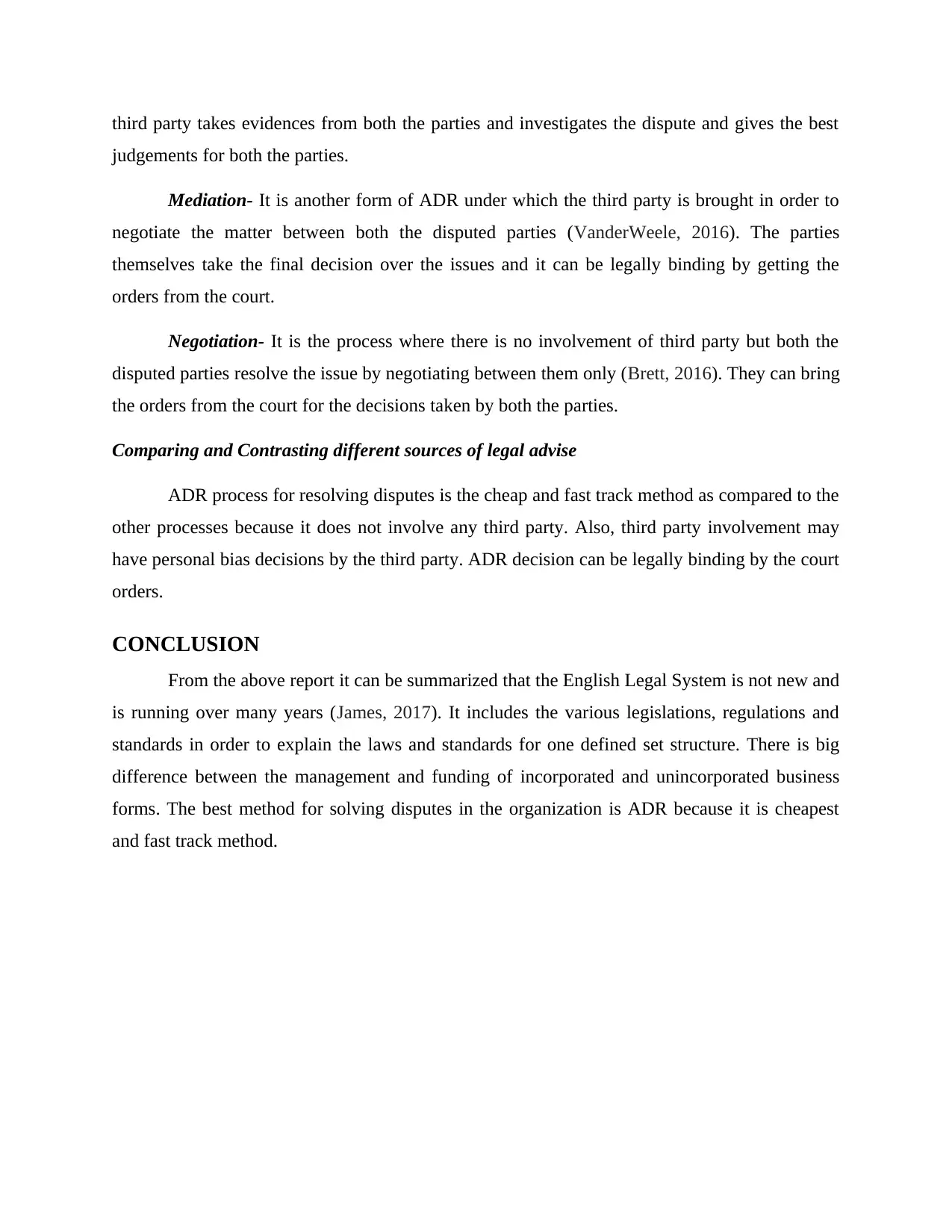
third party takes evidences from both the parties and investigates the dispute and gives the best
judgements for both the parties.
Mediation- It is another form of ADR under which the third party is brought in order to
negotiate the matter between both the disputed parties (VanderWeele, 2016). The parties
themselves take the final decision over the issues and it can be legally binding by getting the
orders from the court.
Negotiation- It is the process where there is no involvement of third party but both the
disputed parties resolve the issue by negotiating between them only (Brett, 2016). They can bring
the orders from the court for the decisions taken by both the parties.
Comparing and Contrasting different sources of legal advise
ADR process for resolving disputes is the cheap and fast track method as compared to the
other processes because it does not involve any third party. Also, third party involvement may
have personal bias decisions by the third party. ADR decision can be legally binding by the court
orders.
CONCLUSION
From the above report it can be summarized that the English Legal System is not new and
is running over many years (James, 2017). It includes the various legislations, regulations and
standards in order to explain the laws and standards for one defined set structure. There is big
difference between the management and funding of incorporated and unincorporated business
forms. The best method for solving disputes in the organization is ADR because it is cheapest
and fast track method.
judgements for both the parties.
Mediation- It is another form of ADR under which the third party is brought in order to
negotiate the matter between both the disputed parties (VanderWeele, 2016). The parties
themselves take the final decision over the issues and it can be legally binding by getting the
orders from the court.
Negotiation- It is the process where there is no involvement of third party but both the
disputed parties resolve the issue by negotiating between them only (Brett, 2016). They can bring
the orders from the court for the decisions taken by both the parties.
Comparing and Contrasting different sources of legal advise
ADR process for resolving disputes is the cheap and fast track method as compared to the
other processes because it does not involve any third party. Also, third party involvement may
have personal bias decisions by the third party. ADR decision can be legally binding by the court
orders.
CONCLUSION
From the above report it can be summarized that the English Legal System is not new and
is running over many years (James, 2017). It includes the various legislations, regulations and
standards in order to explain the laws and standards for one defined set structure. There is big
difference between the management and funding of incorporated and unincorporated business
forms. The best method for solving disputes in the organization is ADR because it is cheapest
and fast track method.
Paraphrase This Document
Need a fresh take? Get an instant paraphrase of this document with our AI Paraphraser
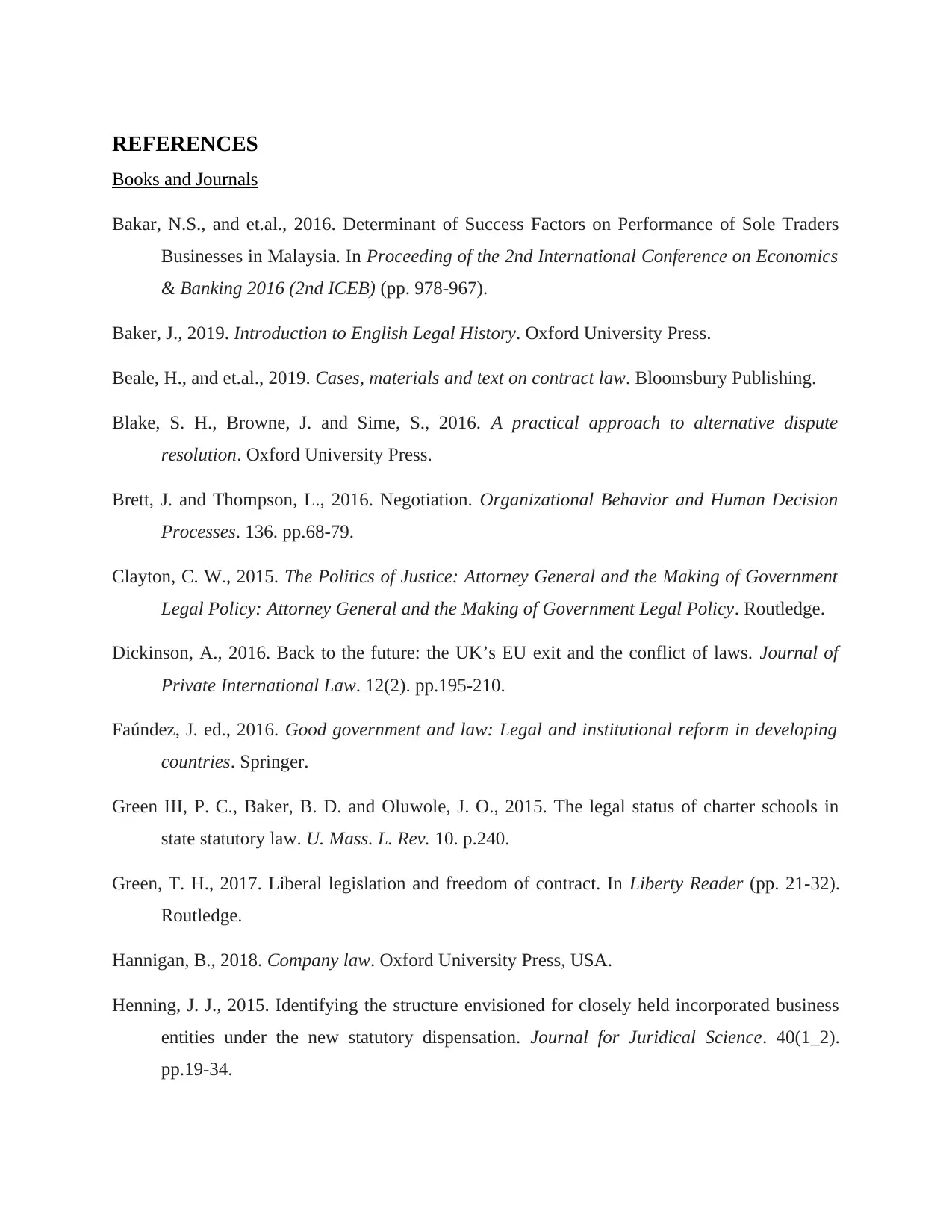
REFERENCES
Books and Journals
Bakar, N.S., and et.al., 2016. Determinant of Success Factors on Performance of Sole Traders
Businesses in Malaysia. In Proceeding of the 2nd International Conference on Economics
& Banking 2016 (2nd ICEB) (pp. 978-967).
Baker, J., 2019. Introduction to English Legal History. Oxford University Press.
Beale, H., and et.al., 2019. Cases, materials and text on contract law. Bloomsbury Publishing.
Blake, S. H., Browne, J. and Sime, S., 2016. A practical approach to alternative dispute
resolution. Oxford University Press.
Brett, J. and Thompson, L., 2016. Negotiation. Organizational Behavior and Human Decision
Processes. 136. pp.68-79.
Clayton, C. W., 2015. The Politics of Justice: Attorney General and the Making of Government
Legal Policy: Attorney General and the Making of Government Legal Policy. Routledge.
Dickinson, A., 2016. Back to the future: the UK’s EU exit and the conflict of laws. Journal of
Private International Law. 12(2). pp.195-210.
Faúndez, J. ed., 2016. Good government and law: Legal and institutional reform in developing
countries. Springer.
Green III, P. C., Baker, B. D. and Oluwole, J. O., 2015. The legal status of charter schools in
state statutory law. U. Mass. L. Rev. 10. p.240.
Green, T. H., 2017. Liberal legislation and freedom of contract. In Liberty Reader (pp. 21-32).
Routledge.
Hannigan, B., 2018. Company law. Oxford University Press, USA.
Henning, J. J., 2015. Identifying the structure envisioned for closely held incorporated business
entities under the new statutory dispensation. Journal for Juridical Science. 40(1_2).
pp.19-34.
Books and Journals
Bakar, N.S., and et.al., 2016. Determinant of Success Factors on Performance of Sole Traders
Businesses in Malaysia. In Proceeding of the 2nd International Conference on Economics
& Banking 2016 (2nd ICEB) (pp. 978-967).
Baker, J., 2019. Introduction to English Legal History. Oxford University Press.
Beale, H., and et.al., 2019. Cases, materials and text on contract law. Bloomsbury Publishing.
Blake, S. H., Browne, J. and Sime, S., 2016. A practical approach to alternative dispute
resolution. Oxford University Press.
Brett, J. and Thompson, L., 2016. Negotiation. Organizational Behavior and Human Decision
Processes. 136. pp.68-79.
Clayton, C. W., 2015. The Politics of Justice: Attorney General and the Making of Government
Legal Policy: Attorney General and the Making of Government Legal Policy. Routledge.
Dickinson, A., 2016. Back to the future: the UK’s EU exit and the conflict of laws. Journal of
Private International Law. 12(2). pp.195-210.
Faúndez, J. ed., 2016. Good government and law: Legal and institutional reform in developing
countries. Springer.
Green III, P. C., Baker, B. D. and Oluwole, J. O., 2015. The legal status of charter schools in
state statutory law. U. Mass. L. Rev. 10. p.240.
Green, T. H., 2017. Liberal legislation and freedom of contract. In Liberty Reader (pp. 21-32).
Routledge.
Hannigan, B., 2018. Company law. Oxford University Press, USA.
Henning, J. J., 2015. Identifying the structure envisioned for closely held incorporated business
entities under the new statutory dispensation. Journal for Juridical Science. 40(1_2).
pp.19-34.
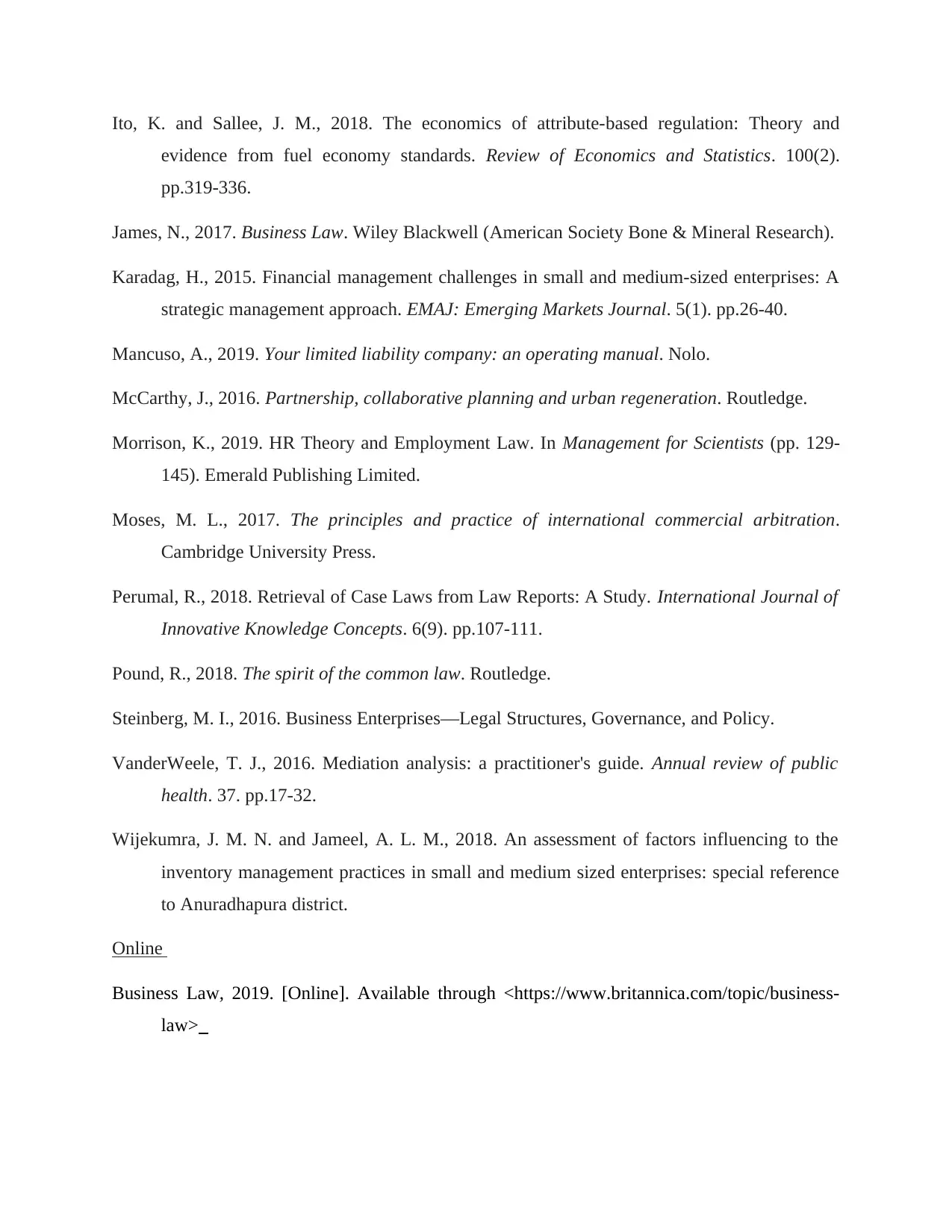
Ito, K. and Sallee, J. M., 2018. The economics of attribute-based regulation: Theory and
evidence from fuel economy standards. Review of Economics and Statistics. 100(2).
pp.319-336.
James, N., 2017. Business Law. Wiley Blackwell (American Society Bone & Mineral Research).
Karadag, H., 2015. Financial management challenges in small and medium-sized enterprises: A
strategic management approach. EMAJ: Emerging Markets Journal. 5(1). pp.26-40.
Mancuso, A., 2019. Your limited liability company: an operating manual. Nolo.
McCarthy, J., 2016. Partnership, collaborative planning and urban regeneration. Routledge.
Morrison, K., 2019. HR Theory and Employment Law. In Management for Scientists (pp. 129-
145). Emerald Publishing Limited.
Moses, M. L., 2017. The principles and practice of international commercial arbitration.
Cambridge University Press.
Perumal, R., 2018. Retrieval of Case Laws from Law Reports: A Study. International Journal of
Innovative Knowledge Concepts. 6(9). pp.107-111.
Pound, R., 2018. The spirit of the common law. Routledge.
Steinberg, M. I., 2016. Business Enterprises—Legal Structures, Governance, and Policy.
VanderWeele, T. J., 2016. Mediation analysis: a practitioner's guide. Annual review of public
health. 37. pp.17-32.
Wijekumra, J. M. N. and Jameel, A. L. M., 2018. An assessment of factors influencing to the
inventory management practices in small and medium sized enterprises: special reference
to Anuradhapura district.
Online
Business Law, 2019. [Online]. Available through <https://www.britannica.com/topic/business-
law>
evidence from fuel economy standards. Review of Economics and Statistics. 100(2).
pp.319-336.
James, N., 2017. Business Law. Wiley Blackwell (American Society Bone & Mineral Research).
Karadag, H., 2015. Financial management challenges in small and medium-sized enterprises: A
strategic management approach. EMAJ: Emerging Markets Journal. 5(1). pp.26-40.
Mancuso, A., 2019. Your limited liability company: an operating manual. Nolo.
McCarthy, J., 2016. Partnership, collaborative planning and urban regeneration. Routledge.
Morrison, K., 2019. HR Theory and Employment Law. In Management for Scientists (pp. 129-
145). Emerald Publishing Limited.
Moses, M. L., 2017. The principles and practice of international commercial arbitration.
Cambridge University Press.
Perumal, R., 2018. Retrieval of Case Laws from Law Reports: A Study. International Journal of
Innovative Knowledge Concepts. 6(9). pp.107-111.
Pound, R., 2018. The spirit of the common law. Routledge.
Steinberg, M. I., 2016. Business Enterprises—Legal Structures, Governance, and Policy.
VanderWeele, T. J., 2016. Mediation analysis: a practitioner's guide. Annual review of public
health. 37. pp.17-32.
Wijekumra, J. M. N. and Jameel, A. L. M., 2018. An assessment of factors influencing to the
inventory management practices in small and medium sized enterprises: special reference
to Anuradhapura district.
Online
Business Law, 2019. [Online]. Available through <https://www.britannica.com/topic/business-
law>
⊘ This is a preview!⊘
Do you want full access?
Subscribe today to unlock all pages.

Trusted by 1+ million students worldwide
1 out of 12
Related Documents
Your All-in-One AI-Powered Toolkit for Academic Success.
+13062052269
info@desklib.com
Available 24*7 on WhatsApp / Email
![[object Object]](/_next/static/media/star-bottom.7253800d.svg)
Unlock your academic potential
Copyright © 2020–2025 A2Z Services. All Rights Reserved. Developed and managed by ZUCOL.





